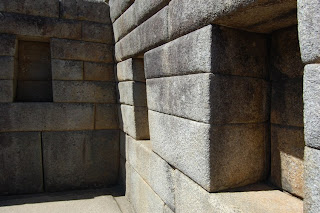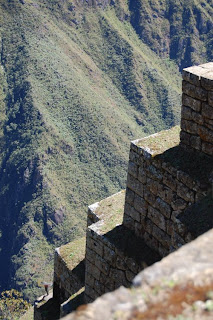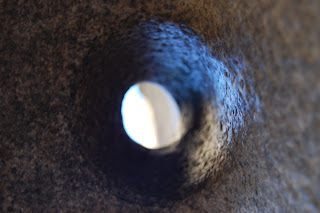30 September 2007
Weaving with Margarita: The Video!
Here is a short video of my fellow weaving student, Leslie, and me in our weaving classes in Huancayo, Peru. Enjoy!
07 August 2007
Thank you's...
New York, NY
To a few of the people who made this adventure as amazing as it was...

To Eugenio and Geovanny Cordova, brothers and founders of the Instituto Superior de Espanol in Quito, as well as my fabulous teachers, Maria Elisabeth and Paula. Eugenio was the first person I met in South America. He picked me up from the airport at 11:30 at night, and made me feel very welcome. In 1988, the school was one of the first to open in Quito, which has now become the capital of Spanish language study in South America. The school is run with the utmost professionalism, and the teachers are well trained and qualified, and know what they are doing! In addition, Geovanny always had excursions around the city and around Ecuador planned and ready to go for anyone who desired. My hands down recommendation for anyone seeking a great travel/study experience!
To Luigina Fossati, the sweet Italian lady who runs Hostal Casapaxi in Quito. For her motherly hospitality - always making sure her guests were safe and well and had everything they needed. When I told her I had studied Italian in college, she proceeded to speak to me in Italian from thereon out, which thoroughly confused me in my attempt to study Spanish at the time!

Lucho Hurtado works a late night in the Incas del Peru office
To Lucho Hurtado, brainchild behind Incas del Peru in Huancayo, adventure leader, entrepreneur, community organizer, visionary, "teacher of life," ...this man never stops! In addition to running two restaurants, an inn, and organizing treks, courses, and excursions, Lucho has led the drive to revive train service on the historic Central Andean line, organizes programs to help children in Huancayo's orphanages, and leads efforts to open his community to the world, following the difficult decades of war and terrorism in the Central Andean region.
 To Margarita for teaching me how to weave in five days! I have no doubt she's reading this right now on her laptop. Even when she grew impatient with me and cursed in Quechua, I had a blast!
To Margarita for teaching me how to weave in five days! I have no doubt she's reading this right now on her laptop. Even when she grew impatient with me and cursed in Quechua, I had a blast!
To Nilda at La Casa de la Abuela in Huancayo. For all the incredible home-cooked meals and warm hospitality, and for cooking me eggs every morning, since I couldn't eat pan. And to her 4-year old nino, the two cats, the dirty, shaggy dog, and the talking parrot who ate my sunscreen lotion, for making the ambiance lively!
 To the kids at Aldea Infantil el Rosario orphanage in Huancayo for opening up their world to me for an afternoon, and to the people at Fundacion por Los Ninos del Peru who look after them.
To the kids at Aldea Infantil el Rosario orphanage in Huancayo for opening up their world to me for an afternoon, and to the people at Fundacion por Los Ninos del Peru who look after them.
 To my guides, Pedro at the Quilatoa Lagoon in Ecuador, Dennis at Yarina Lodge in the Ecuadorian Amazon, and to David and Gladys from Peru Treks, who took special care to look after me while I was sick on the Inca Trail, as well as a huge thanks to the chaskes (porters), who helped carry my load on the Trail. If you hike the Inca Trail, Peru Treks comes highly recommended, not only for the excellence and professionalism of their service, but for their exceptional attention to the
To my guides, Pedro at the Quilatoa Lagoon in Ecuador, Dennis at Yarina Lodge in the Ecuadorian Amazon, and to David and Gladys from Peru Treks, who took special care to look after me while I was sick on the Inca Trail, as well as a huge thanks to the chaskes (porters), who helped carry my load on the Trail. If you hike the Inca Trail, Peru Treks comes highly recommended, not only for the excellence and professionalism of their service, but for their exceptional attention to the  welfare of their porters, and for the community projects they are involved with in the towns from which their porters are hired.
welfare of their porters, and for the community projects they are involved with in the towns from which their porters are hired.


To Carol LeBreck and Judith Freund at the Global Links Global Educators Program, who understand the value of incorporating global learning and teaching experiences such as this into school curricula.
To the many fellow travelers who shared time and experiences with me on the trail. Even though I traveled solo, I was almost never alone! Thanks for the companionship and camaraderie along the way. And of course, to all the Ecuadorians and Peruvians whose warmth and hospitality were extraordinary. All the dire warnings of crime and danger proved wrong - at least in my experience. Don't be afraid to travel to this wonderful part of the world. Keep your wits about you, as you would almost anywhere, and you will experience nothing but a warm and enthusiastic welcome!
To a few of the people who made this adventure as amazing as it was...

To Eugenio and Geovanny Cordova, brothers and founders of the Instituto Superior de Espanol in Quito, as well as my fabulous teachers, Maria Elisabeth and Paula. Eugenio was the first person I met in South America. He picked me up from the airport at 11:30 at night, and made me feel very welcome. In 1988, the school was one of the first to open in Quito, which has now become the capital of Spanish language study in South America. The school is run with the utmost professionalism, and the teachers are well trained and qualified, and know what they are doing! In addition, Geovanny always had excursions around the city and around Ecuador planned and ready to go for anyone who desired. My hands down recommendation for anyone seeking a great travel/study experience!
To Luigina Fossati, the sweet Italian lady who runs Hostal Casapaxi in Quito. For her motherly hospitality - always making sure her guests were safe and well and had everything they needed. When I told her I had studied Italian in college, she proceeded to speak to me in Italian from thereon out, which thoroughly confused me in my attempt to study Spanish at the time!

Lucho Hurtado works a late night in the Incas del Peru office
To Lucho Hurtado, brainchild behind Incas del Peru in Huancayo, adventure leader, entrepreneur, community organizer, visionary, "teacher of life," ...this man never stops! In addition to running two restaurants, an inn, and organizing treks, courses, and excursions, Lucho has led the drive to revive train service on the historic Central Andean line, organizes programs to help children in Huancayo's orphanages, and leads efforts to open his community to the world, following the difficult decades of war and terrorism in the Central Andean region.
 To Margarita for teaching me how to weave in five days! I have no doubt she's reading this right now on her laptop. Even when she grew impatient with me and cursed in Quechua, I had a blast!
To Margarita for teaching me how to weave in five days! I have no doubt she's reading this right now on her laptop. Even when she grew impatient with me and cursed in Quechua, I had a blast!To Nilda at La Casa de la Abuela in Huancayo. For all the incredible home-cooked meals and warm hospitality, and for cooking me eggs every morning, since I couldn't eat pan. And to her 4-year old nino, the two cats, the dirty, shaggy dog, and the talking parrot who ate my sunscreen lotion, for making the ambiance lively!
 To the kids at Aldea Infantil el Rosario orphanage in Huancayo for opening up their world to me for an afternoon, and to the people at Fundacion por Los Ninos del Peru who look after them.
To the kids at Aldea Infantil el Rosario orphanage in Huancayo for opening up their world to me for an afternoon, and to the people at Fundacion por Los Ninos del Peru who look after them. To my guides, Pedro at the Quilatoa Lagoon in Ecuador, Dennis at Yarina Lodge in the Ecuadorian Amazon, and to David and Gladys from Peru Treks, who took special care to look after me while I was sick on the Inca Trail, as well as a huge thanks to the chaskes (porters), who helped carry my load on the Trail. If you hike the Inca Trail, Peru Treks comes highly recommended, not only for the excellence and professionalism of their service, but for their exceptional attention to the
To my guides, Pedro at the Quilatoa Lagoon in Ecuador, Dennis at Yarina Lodge in the Ecuadorian Amazon, and to David and Gladys from Peru Treks, who took special care to look after me while I was sick on the Inca Trail, as well as a huge thanks to the chaskes (porters), who helped carry my load on the Trail. If you hike the Inca Trail, Peru Treks comes highly recommended, not only for the excellence and professionalism of their service, but for their exceptional attention to the  welfare of their porters, and for the community projects they are involved with in the towns from which their porters are hired.
welfare of their porters, and for the community projects they are involved with in the towns from which their porters are hired.

To Carol LeBreck and Judith Freund at the Global Links Global Educators Program, who understand the value of incorporating global learning and teaching experiences such as this into school curricula.
To the many fellow travelers who shared time and experiences with me on the trail. Even though I traveled solo, I was almost never alone! Thanks for the companionship and camaraderie along the way. And of course, to all the Ecuadorians and Peruvians whose warmth and hospitality were extraordinary. All the dire warnings of crime and danger proved wrong - at least in my experience. Don't be afraid to travel to this wonderful part of the world. Keep your wits about you, as you would almost anywhere, and you will experience nothing but a warm and enthusiastic welcome!
Home!
05 August 2007
Museo de Arte de Lima
Lima, Peru

Francisco Laso"La Lavandera" (1858)Óleo sobre lienzoMuseo de Arte, Lima
This morning I wandered through the Museo de Arte de Lima on this cloudy last day in South America. The Pre-Columbian ceramics and textiles were fascinating as ever, and I found some interesting paintings by early Modern Peruvian painters Francisco Laso, Teófilo Castillo, and Julia Codesido.

Julia Codesido. Cristo de la Cruz Verde, siglo XXAcrílico sobre lienzo, 67.5 x 48 cm
What caught my attention the most was an exhibition of the work of Josef and Anni Albers. I had not known of the work of Josef´s wife, Anni, nor had I known of their intense interest and experience in Latin America, and its influence on their artwork. The couple spent time living and working in Mexico, where Josef was inspired by the geometric forms of Aztec architecture and design motifs - which led to the geometric compositions in a lot of his work. While in Mexico, he also did a lot of his color studies using natural pigments found in the area.
Josef Albers, Adobe (Variant): Luminous Day, 1947/52Oil on masonite. JAAF: 1976.1.1382. 28 x 53.34 cm (11 x 21 inches)
Anni Albers, La Luz I, 1947Cotton, hemp, and metallic gimp. JAAF: 1994.12.247 x 82.5 cm (18-1/2 x 32-1/2 inches)
The two also did a lot of traveling in South America, including to Peru, where Anni studied textile designs, and incorporated weaving and textiles into her art in some very interesting ways. As I contemplate how to incorporate what I have seen and learned into meaningful lessons for my students and into strands of my own artwork, seeing this bridge between the Modern Art world and the ancient traditions of Latin America was a timely and intriguing find!
03 August 2007
Isla Taquile, Lake Titicaca
Lake Titicaca, Peru
The island has been inhabited for thousands of years by a lineage of Quechua-speaking people who have maintained a distinct cultural identity from the peoples of the mainland. They have rich artisan traditions, including the knitting of hats (done by men) and weaving (by women). You can often see the men and boys knitting hats as they go about their daily routines on the island.
Nestled between the Andes and the Altiplano, Lake Titicaca is the largest lake in South America. At over 12,000 ft. above sea level, it is the world´s highest navigable lake. It is also the cradle of Peru´s ancient civilizations, including the Inca. The myth goes that the first Inca, Manco Capac was born of the Sun god Inti here, and emerged from the Lake to bring forth the Inca Empire. There is a white statue of Manco Capac looking down over the port town of Puno (albeit with a cross in his hand).
Manco Capac looks down over Puno and Lake Titicaca
The sun is very brilliant over the water, the colors intense, and like everywhere in the Andes, the sky is always a dramatic display of clouds and light. Ride the boat out two and a half hours, and you will arrive at Taquile Island.
The island has been inhabited for thousands of years by a lineage of Quechua-speaking people who have maintained a distinct cultural identity from the peoples of the mainland. They have rich artisan traditions, including the knitting of hats (done by men) and weaving (by women). You can often see the men and boys knitting hats as they go about their daily routines on the island.
Boys practice their knitting skills
Kite-flying on Taquile
Tourism changes everything
Floating Islands of Lake Titicaca
Lake Titicaca, Peru
The Uros are a Pre-Inca group of indigenous Peruvians who have lived for centuries on floating islands made from layers of the totora reeds that grow in the shallow areas of Lake Titicaca. The islands are built on a foundation of roots of the reeds, in meter-thick blocks, which are bound together and anchored to the bottom of the lake. Layers of reeds are then laid upon the root blocks, and are replenished regularly to replace areas that have rotted. Nearly everything else on the islands are also made from the reeds, including buildings, canoes, furniture, and toys for the children. Part of the root is also eaten as a staple of the Uros´diet, in addition to fish and rice.
01 August 2007
On the Trail of the Inca / Machu Picchu
(30 July)


Inca Trail - Machu Picchu, Peru
This one is for the ever fabulous Reneé Darvin.
This one is for the ever fabulous Reneé Darvin.
Our last morning on the Inca Trail, we are up at 3:30am. The checkpoint five minutes downhill opens at 5:30am. The problem is there are many groups camped out, waiting to pass through the checkpoint when it opens, so we need to get there early to be at the front of the line. Once we are cleared, we have about a two hour hike to get to Machu Picchu. The anticipation is great, and the morning is still and quiet. At sunrise, we approach Intipata, the Sun Gate, from which the first views of the Machu Picchu citadel can be seen below. We´ve made it!
It´s almost another hour´s walk to get down to Machu Picchu, watching its stone contours and alleyways emerge below the rising sun. Illness, foot blisters, callouses, sore muscles, aches, and hammered knees all fade away. We are basking in the glow of arrival.
Already the buses are exhaling tourists from Auguas Calientas by the hundreds at this early hour, but at least we have the relative quiet of the morning to take in the vastness of the place. By noon, the site will be literally flooded - resembling an amusement park. The park regulations allow 2,500 tourists to enter per day. I feel entitled to my space, having walked for three and a half days to get here, but I too am one of the millions who are contributing to the demise of this precious jewel. A group of Japanese scientists recently found that the terraces at the edges of Machu Picchu are sloping downward at a rate of 2cm per month, due to the heavy traffic on the delicate site. It is not unforeseeable that this will be a site only visible from a distance at some point in the near future.


Subscribe to:
Posts (Atom)


LuminousDay.jpg)















































